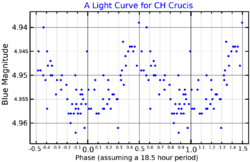Astronomy:CH Crucis
| Observation data Equinox J2000.0]] (ICRS) | |
|---|---|
| Constellation | Crux |
| Right ascension | 12h 41m 56.56824s[2] |
| Declination | −59° 41′ 08.9564″[2] |
| Apparent magnitude (V) | 4.91[3] |
| Characteristics | |
| Spectral type | B5III[4] or B6IV[5] |
| U−B color index | −0.37[6] |
| B−V color index | −0.044±0.03[3] |
| Variable type | γ Cas?[7] |
| Astrometry | |
| Radial velocity (Rv) | +12.5±2.8[3] km/s |
| Proper motion (μ) | RA: -23.987[2] mas/yr Dec.: -4.110[2] mas/yr |
| Parallax (π) | 4.2068 ± 0.1651[2] mas |
| Distance | 780 ± 30 ly (238 ± 9 pc) |
| Absolute magnitude (MV) | −2.41[3] |
| Details | |
| Mass | 5.30±0.27[8] M☉ |
| Radius | 11.20±0.22[9] R☉ |
| Luminosity | 1,073[3] L☉ |
| Surface gravity (log g) | 2.90±0.03[9] cgs |
| Temperature | 10,600±106[9] K |
| Rotational velocity (v sin i) | 240[10] km/s |
| Age | 120[11][better source needed] Myr |
| Other designations | |
| Database references | |
| SIMBAD | data |
CH Crucis is a solitary[14] variable star in the southern constellation of Crux. It has the Gould designation 39 G. Crucis.[12] The object is visible to the naked eye as a faint, blue-white hued point of light with an apparent visual magnitude that fluctuates around 4.91.[3] The star is located approximately 780 light years distant from the Sun based on parallax,[2] and is drifting further away with a radial velocity of about +12.5 km/s.[3] It is a member of the nearby Sco OB2 association.[15]
This is a conventional shell star, which is understood to be a Be star that is being viewed edge-on.[16] Houk (1975) found a stellar classification of B5III,[4] while Hiltner et al. assigned it to B6IV;[5] suggesting it is a B-type star that is evolving off the main sequence.[8] Samus et al. (2017) have tentatively classified it as a Gamma Cassiopeiae variable that ranges in brightness from magnitude 4.88 down to 5.7.[7]
CH Crucis has 5.3[8] times the mass of the Sun and 11.2[9] times the Sun's radius. It is radiating 1,073[3] times the luminosity of the Sun from its photosphere at an effective temperature of 10,600 K.[9] It is spinning rapidly with estimates of the projected rotational velocity ranging up to 240 or 250 km/s.[16][10] This is giving the star an oblate shape with an equatorial bulge that is an estimated 18% larger than the polar radius.[10]
References
- ↑ Balona, L. A.; Cuypers, J.; Marang, F. (February 1992). "Intensive photometry of southern Be variables. II. Summer objects". Astronomy & Astrophysics Supplement Series 92: 533–563. Bibcode: 1992A&AS...92..533B. https://ui.adsabs.harvard.edu/abs/1992A&AS...92..533B. Retrieved 18 December 2021.
- ↑ 2.0 2.1 2.2 2.3 2.4 2.5 Brown, A. G. A. (August 2018). "Gaia Data Release 2: Summary of the contents and survey properties". Astronomy & Astrophysics 616: A1. doi:10.1051/0004-6361/201833051. Bibcode: 2018A&A...616A...1G. Gaia DR2 record for this source at VizieR.
- ↑ 3.0 3.1 3.2 3.3 3.4 3.5 3.6 3.7 Anderson, E.; Francis, Ch. (2012), "XHIP: An extended hipparcos compilation", Astronomy Letters 38 (5): 331, doi:10.1134/S1063773712050015, Bibcode: 2012AstL...38..331A.
- ↑ 4.0 4.1 Houk, Nancy (1978), Michigan catalogue of two-dimensional spectral types for the HD stars, 1, Ann Arbor: Dept. of Astronomy, University of Michigan, Bibcode: 1975mcts.book.....H.
- ↑ 5.0 5.1 Hiltner, W. A.; Garrison, R. F.; Schild, R. E. (July 1969), "MK Spectral Types for Bright Southern OB Stars", Astrophysical Journal 157: 313–326, doi:10.1086/150069, Bibcode: 1969ApJ...157..313H.
- ↑ "39 Crucis, a blue subgiant star in Crux", Ashland Astronomy Studio, http://www.astrostudio.org/xhip.php?hip=61966, retrieved 2012-08-23
- ↑ 7.0 7.1 Samus', N. N; Kazarovets, E. V; Durlevich, O. V; Kireeva, N. N; Pastukhova, E. N (2017), "General catalogue of variable stars: Version GCVS 5.1", Astronomy Reports 61 (1): 80, doi:10.1134/S1063772917010085, Bibcode: 2017ARep...61...80S.
- ↑ 8.0 8.1 8.2 Zorec, J. et al. (2012), "Rotational velocities of A-type stars. IV. Evolution of rotational velocities", Astronomy and Astrophysics 537: A120, doi:10.1051/0004-6361/201117691, Bibcode: 2012A&A...537A.120Z.
- ↑ 9.0 9.1 9.2 9.3 9.4 Arcos, C. et al. (March 2018), "Stellar parameters and H α line profile variability of Be stars in the BeSOS survey", Monthly Notices of the Royal Astronomical Society 474 (4): 5287–5299, doi:10.1093/mnras/stx3075, Bibcode: 2018MNRAS.474.5287A.
- ↑ 10.0 10.1 10.2 Belle, G. T. (2012), "Interferometric observations of rapidly rotating stars", The Astronomy and Astrophysics Review 20 (1): 51, doi:10.1007/s00159-012-0051-2, Bibcode: 2012A&ARv..20...51V.
- ↑ "HIP 61966", Wolfram Alpha, http://www.wolframalpha.com/input/?i=HIP+61966, retrieved 2012-08-23
- ↑ 12.0 12.1 Gould, Benjamin Apthorp (1879), "Uranometria Argentina catalog of bright southern stars", Resultados del Observatorio Nacional Argentino 1, Bibcode: 1879RNAO....1.....G, http://vizier.u-strasbg.fr/viz-bin/VizieR?-source=V%2F135%2Fcatalog, retrieved 2012-05-08.
- ↑ "CH Cru". SIMBAD. Centre de données astronomiques de Strasbourg. http://simbad.u-strasbg.fr/simbad/sim-basic?Ident=CH+Cru.
- ↑ Eggleton, P. P.; Tokovinin, A. A. (September 2008), "A catalogue of multiplicity among bright stellar systems", Monthly Notices of the Royal Astronomical Society 389 (2): 869–879, doi:10.1111/j.1365-2966.2008.13596.x, Bibcode: 2008MNRAS.389..869E.
- ↑ Hoogerwerf, Ronnie (March 2000), "OB association members in the ACT and TRC catalogues", Monthly Notices of the Royal Astronomical Society 313 (1): 43–65, doi:10.1046/j.1365-8711.2000.03192.x, Bibcode: 2000MNRAS.313...43H.
- ↑ 16.0 16.1 Rivinius, Th. et al. (November 2006), "Bright Be-shell stars", Astronomy and Astrophysics 459 (1): 137–145, doi:10.1051/0004-6361:20053008, Bibcode: 2006A&A...459..137R.
 |


